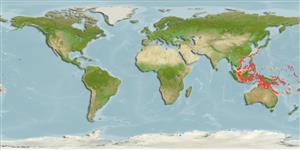Environment: milieu / climate zone / εύρος βάθους / distribution range
Οικολογία
Θαλασσινό(ά) Υφαλόφιλο(α); μη μεταναστευτικό(ά); εύρος βάθους 1 - 68 m (Ref. 37816). Tropical; 35°N - 25°S, 104°E - 173°W
Western Pacific: Sumatra to Vanuatu, north to the Ryukyu Islands, south to New Caledonia. Recently recorded from Tonga (Ref. 53797).
Μέγεθος / Βάρος / Age
Γεννητική Ωρίμανση: Lm ? range ? - ? cm
Max length : 8.0 cm TL αρσενικό/απροσδιόριστο; (Ref. 9710)
Short description
Κλείδες προσδιορισμού | Μορφολογία | Μορφομετρία
Ραχιαίες άκανθες (συνολικά) : 12; Μαλακές ραχιαίες ακτίνες (συνολικά) : 12 - 13; Εδρικές άκανθες: 2; Μαλακές εδρικές ακτίνες: 12 - 13. Color in life white with 3 black bars; has a black area over the outer two-thirds of the tail, which distinguishes it from D. aruanus; pelvic fins black; pectoral fins transparent. Tubed lateral lines scales 16 to 17. Margins of preorbital, suborbital, and preoperculum finely serrated (Ref. 2746). Body depth 1.5-1.7 in SL (Ref. 90102).
Body shape (shape guide): short and / or deep; Cross section: compressed.
Schooling species, adults inhabit sheltered lagoons, harbors and inlets. Also in somewhat open substrates with outcrops of Acropora corals (Ref. 48636). Often associated with small coral heads. Feed on a variety of plankton, including larval shrimps and crabs, algae, ostracods, amphipods, pelagic tunicates, copepods, and fish eggs. Oviparous, distinct pairing during breeding (Ref. 205). Eggs are demersal and adhere to the substrate (Ref. 205). Males guard and aerate the eggs (Ref. 205). Diurnal species (Ref. 54980; 113699).
Life cycle and mating behavior
Γεννητική Ωρίμανση | Αναπαραγωγή | Γεννοβολία | Αβγά | Γονιμότητα | Προνύμφες
Oviparous, distinct pairing during breeding (Ref. 205). Eggs are demersal and adhere to the substrate (Ref. 205). Males guard and aerate the eggs (Ref. 205).
Allen, G.R., 1991. Damselfishes of the world. Mergus Publishers, Melle, Germany. 271 p. (Ref. 7247)
IUCN Red List Status (Ref. 130435: Version 2025-1)
Threat to humans
Harmless
Human uses
αλιεία: Εμπορικό(ά); Ενυδρείο: Εμπορικό(ά)
Εργαλεία
Special reports
Download XML
Διαδικτυακές πηγές
Estimates based on models
Preferred temperature (Αναφ.
123201): 24.9 - 29, mean 27.8 °C (based on 648 cells).
Phylogenetic diversity index (Αναφ.
82804): PD
50 = 0.5005 [Uniqueness, from 0.5 = low to 2.0 = high].
Bayesian length-weight: a=0.02089 (0.00944 - 0.04623), b=2.98 (2.80 - 3.16), in cm total length, based on LWR estimates for this (Sub)family-body shape (Ref.
93245).
Τροφικό Επίπεδο (Αναφ.
69278): 3.0 ±0.36 se; based on food items.
Ελαστικότητα (Αναφ.
120179): Υψηλό, ελάχιστος χρόνος για διπλασιασμό πληθυσμού < 15 μήνες (Preliminary K or Fecundity.).
Fishing Vulnerability (Ref.
59153): Low vulnerability (10 of 100).
🛈
Nutrients (Ref.
124155): Calcium = 132 [64, 202] mg/100g; Iron = 0.829 [0.495, 1.391] mg/100g; Protein = 18.2 [17.0, 19.4] %; Omega3 = 0.136 [0.079, 0.226] g/100g; Selenium = 28.6 [15.1, 53.5] μg/100g; VitaminA = 95.6 [26.6, 325.7] μg/100g; Zinc = 1.82 [1.23, 2.62] mg/100g (wet weight);
